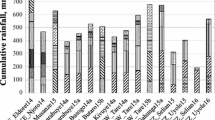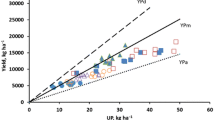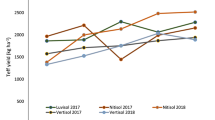Abstract
Wheat and maize are two major food crops in China. Conventional fertilizer recommendations result in higher than necessary costs to farmers and increased environmental pollution. It is essential to quantitatively estimate optimal fertilizer requirements to alleviate the problems of the two crops in China. The QUEFTS (QUantitative Evaluation of the Fertility of Tropical Soils) model was used to estimate region-specific nitrogen (N), phosphorus (P) and potassium (K) requirements as well as fertilizer applications needed to realize target yields of wheat and maize. Data of field experiments with different fertilization treatments of various regions in China during the years of 1985–1995 were used to calibrate the QUEFTS model for both wheat and maize. Minimum and maximum internal nutrient efficiencies (kg grain kg−1) for the model were estimated at N (25 and 56), P (171 and 367), K (24 and 67) for wheat, and N (21 and 64), P (126 and 384), K (20 and 90) for maize. The model suggested a linear increase of grain yields for scenarios with nutrient contents of 24.6, 3.7 and 23.0 kg N, P and K per 1000 kg of wheat grain and 25.8, 4.3 and 23.1 kg N, P and K per 1000 kg of maize grain. These results suggest that the average N: P: K ratio in the plant dry matter is about 6.7: 1: 6.2 for wheat and 6.0: 1: 5.4 for maize. Relationships between internal N, P and K levels and soil properties were established and relationships between the recovery efficiencies of applied fertilizer – N, P and K were found. Running the calibrated QUEFTS model with observed field data produced a good fit between predicted and observed data. It was concluded that the calibrated QUEFTS model could be a useful tool for improving fertilizer recommendations for wheat and maize in China.
Similar content being viewed by others
References
Bremner J.M. (1965). Total nitrogen. In: Black C.A. (eds). Methods of Soil Analysis, Part 1 Physical and Mineralogical Properties, Including Statistics of Measurement and Sampling. ASA, SSSAJ, Madison, WI, USA, pp. 1149–1178
Cassman K.G., Gines G.C., Dizon M.A., Samson M.I. and Alcantara J.M. (1996). Nitrogen use efficiency in tropical low-land rice systems: contribution of indigenous and applied nitrogen. Field Crops Res. 47:1–12
Dobermann A. and White P.F. (1999). Strategies for nutrient management in irrigated and rainfed rice systems. Nutr. Cycling Agroecosyst. 53:1–18
Gao X.Z., Ma W.Q., Cui Y., Wang R.F. and Zhang F.S. (2000). Changes of soil nutrient contents and input of nutrients in arable of China. Plant Nutr. Fertilizer Sci. 6:363–369
Haefele S.M., Wopereis M.C.S., Ndiaye M.K., Barro S.E. and Ould Isselmou M. (2003). Internal nutrient efficiencies, fertilizer recovery rates and indigenous nutrient supply of irrigated lowland rice in Sahelian West Africa. Field Crops Res. 80:19–32
Janssen B.H., Guiking F.C.T., Braakhekke W.G. and Dohme P.A.E. (1992). Quantitative evaluation of soil fertility and the response to fertilizers. Department of Soil Science and Plant Nutrition, Wageningen, The Netherlands
Janssen B.H., Guiking F.C.T., Van der Eijk D., Smaling E.M.A., Wolf J. and Van Reuler H. (1990). A system for quantitative evaluation of the fertility of tropical soils (QUEFTS). Geoderma 46:299–318
Kalembasa S.J. and Jenkinson D.S. (1973). A comparative study of titrimetric and gravimetric methods for the determination of organic carbon in soil. J. Sci. Food Agric. 24:1085–1090
Knudsen D., Peterson G.A. and Pratt P.F. (1982). Lithium, sodium and potassium. In: Page A.L. (eds). Methods of Soil Analysis, Part 2 Chemical and Microbiological Properties. ASA, SSSAJ, Madison, WI, USA, pp. 225–245
Li B.H., Huang S.J. and Dong P.Y. (1990). The theory and technology of high production of maize in Huang Huai Hai plain. Science and Technology Press, Beijing, China
Li Y.Z., Lu J.W. and Luo Y.P. (1994). Efficiently use of soil nutrient in China. Beijing Agricultural University Press, Beijing, China
Liu X.H. (1987). Zoning of the cropping systems in China. Beijing Agricultural University Press, Beijng, China
Mao Z.Q. 2003. Sustainable management of winter wheat production based on field experiments and crop growth simulation. Ph.D. Thesis. China Agricultural University, Beijing, China
National Statistic Bureau (2001). China Agricultural Yearbook. Agricultural Publishing House, Beijing, China
Olsen S.R., Cole C.V., Watanabe F.S. and Dean L.A. (1954). Estimation of Available Phosphorus in Soils by Extraction with Sodium Bicarbonate. USDA Circular NO. 939. USDA, Washington, DC
Pathak H., Aggarwal P.K., Roetter R., Kalra N., Bandyopadhaya S.K., Prasad S. and Van Keulen H. (2003). Modelling the quantitative evaluation of soil nutrient supply, nutrient use efficiency, and fertilizer requirements of wheat in India. Nutr. Cycling Agroecosyst. 65:105–113
Saidou A., Janssen B.H. and Temminghoff E.J.M. (2003). Effects of soil properties, mulch and NPK fertilizer on maize yields and nutrient budgets on ferralitic soils in southern Benin. Agric. Ecosyst. Environ. 100:265–273
Smaling E.M.A. and Janssen B.H. (1993). Calibration of QUEFTS, a model predicting nutrient uptake and yields from chemical soil fertility indices. Geoderma 59:21–44
Song X. (1993). Soil Nutrient, Plant Nutrient and Balance Fertilizer Application. China Agricultural Press, Beijing, China
Witt C., Dobermann A., Abdulrachman S., Gines H.C., Wang G..H., Nagarajan R., Satawatananont S., Tran T.S., Pham S.T., Le Van T., Simbahan G.C. and Olk D.C. (1999). Internal nutrient efficiencies of irrigated lowland rice in tropical and subtropical Asia. Field Crops Res. 63:113–138
Xie J.C., Xing W.Y. and Zhou J.M. (1998). Current use of, and requirement for, nutrients for sustainable food production in China. In: Johnson A.E. and Syers J.K. (eds). Nutrient Management for Sustainable Crop Production in Asia. CAB International, Wallingford, pp. 267–277
Yang S.C. (1991). The optimal fertilizer application technology of main Crops in Huang Huai Hai plain. China Agricultural Science and Technology Press, Beijing, China
Zhang F.S. (2003). Nutrient Resource Management. China Agricultural University Press, Beijing, China
Zhang Y.S. (2001). Sustainable Management of Summer Maize Production Aided by Crop Growth Simulation Model. Ph.D. Thesis. China Agricultural University, Beijing, China
Zhu Z.L. and Chen D.L. (2002). Nitrogen fertilizer use in China – contributions to food production, impacts on the environment and best management strategies. Nutr. Cycling Agroecosyst. 63:117–127
Zu K.Q., Mao D.R. and Wang X.R. (1990). Economical fertilizer application in the low production of HuangHuangHai Plain. Beijing Agricultural University Press, Beijing, China
Acknowledgements
This research supported by the National Basic Research Program of China (Project 2005CB121103) and the Sino-Dutch Project (LUW/CHI/971) founded by the Dutch SAIL foundation and Chinese Ministry of Education (985␣project). The authors also thank Prof. P.M. Driessen, Department of Environmental sciences, Wageningen University, The Netherlands, for his correction of English on the manuscript. We furthermore like to thank the unknown reviewers and the editor for their valuable comments, which were of great help in improving the manuscript.
Author information
Authors and Affiliations
Corresponding author
Rights and permissions
About this article
Cite this article
Liu, M., Yu, Z., Liu, Y. et al. Fertilizer requirements for wheat and maize in China: the QUEFTS approach. Nutr Cycl Agroecosyst 74, 245–258 (2006). https://doi.org/10.1007/s10705-006-9002-5
Received:
Accepted:
Published:
Issue Date:
DOI: https://doi.org/10.1007/s10705-006-9002-5




